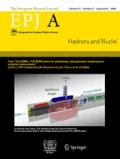Abstract.
The role of different density approximations such as frozen, sudden and modified sudden, investigated within the Skyrme Energy Density Formalism (SEDF), is compared with the phenomenological relaxed-density approach for Ni-based reactions. These approximations give different ways in which individual densities of projectile and target can be added for obtaining compound nucleus density. For the 58Ni + 58Ni reaction, unlike sudden, the frozen density approximation is known to give the realistic barrier parameters (Nucl. Phys. A 870-871, 42 (2011)) and addresses the experimental data with the use of the extended \( \ell\) -summed Wong model. In view of this, the barrier parameters within the sudden approximation are obtained, by modifying the central density term as an independent function of the surface thickness factor, which in turn, fits the data nicely at sub barrier energies. In comparison to this, the largest barrier height of the phenomenological potential of relaxed-density advocates the possibility of fusion hindrance. Additionally, for the 18O and 40Ca + 58Ni reactions, the frozen and modified sudden approximations address the data at below barrier-energies. For the case of a heavier-mass system, the barrier parameters cannot be extracted due to the disappeared pocket for the case of sudden and modified sudden density approximations. In such situation, the frozen and relaxed-density approaches behave in a similar manner and show a better fit to the data using the extended \( \ell\) -summed Wong formula. The \( \ell\)-values are extracted using the sharp cut-off model for above-barrier energies and extrapolated at lower energies. Among the chosen approximations, the frozen approximation seems to provide a better option for the reactions considered from different mass regions. Further, on the basis of frozen and phenomenological approaches, the reduced cross-sections are calculated and compared with the Universal Fusion Function (UFF) for symmetric and asymmetric choices of nuclear partners.
Similar content being viewed by others
References
T.H.R. Skyrme, Philos. Mag. 1, 1043 (1956)
T.H.R. Skyrme, Nucl. Phys. 9, 615 (1959)
K.A. Brueckner, J.R. Buchler, M. Kelley, Phys. Rev. 173, 944 (1968)
D. Vautherin, D.M. Brink, Phys. Rev. C 5, 626 (1972)
Fl. Stancu, D.M. Brink, Nucl. Phys. A 270, 236 (1976)
I. Dutt, R.K. Puri, Phys. Rev. C 81, 044615 (2010)
R. Kumar, M.K. Sharma, R.K. Gupta, Nucl. Phys. A 870-871, 42 (2011)
Li Guo-Qiang, J. Phys. G: Nucl. Part. Phys. 17, 1 (1991)
R. Kumar, Phys. Rev. C 84, 044613 (2011)
M. Brack, C. Guet, H.-B. Hakansson, Phys. Rep. 123, 275 (1985)
T. Ichikawa, Phys. Rev. C 92, 064604 (2015)
V.M. Strutinsky, A.G. Magner, V.Yu. Denisov, Z. Phys. A 322, 149 (1985)
E. Chabanat et al., Nucl. Phys. A 635, 231 (1998)
V.Yu. Denisov, Phys. Rev. C 91, 024603 (2015)
M. Beckerman et al., Phys. Rev. C 23, 4 (1981)
A.M. Borges et al., Phys. Rev. C 46, 6 (1992)
D. Bourgin et al., Phys. Rev. C 90, 044610 (2014)
Z. Kohley et al., Phys. Rev. Lett. 107, 202701 (2011)
C.Y. Wong, Phys. Rev. Lett. 31, 12 (1973)
R. Kumar, M. Bansal, S.K. Arun, R.K. Gupta, Phys. Rev. C 80, 034618 (2009)
V.V. Sargsyan et al., Phys. Rev. C 95, 054619 (2017)
P. Chattopadhyay, R.K. Gupta, Phys. Rev. C 30, 1191 (1984)
J. Blocki et al., Ann. Phys. 105, 427 (1977)
R.K. Gupta, D. Singh, W. Greiner, Phys. Rev. C 75, 024603 (2007)
H. Dries et al., At. Data Nucl. Tables 36, 495 (1987)
D.L. Hill, J.A. Wheeler, Phys. Rev. 89, 5 (1953)
Z. Kohley et al., Phys. Rev. Lett. 107, 202701 (2011)
H.A. Aljuwair et al., Phys. Rev. C 30, 1223 (1984)
R. Vandenbosch et al., J. Phys. G 23, 1303 (1997)
H. Timmers et al., Phys. Lett. B 399, 35 (1997)
Author information
Authors and Affiliations
Corresponding author
Additional information
Communicated by M. Bender
Rights and permissions
About this article
Cite this article
Jain, S., Kumar, R. & Sharma, M.K. Effect of different nuclear density approximations on fusion dynamics within Skyrme Energy Density Formalism. Eur. Phys. J. A 54, 203 (2018). https://doi.org/10.1140/epja/i2018-12625-0
Received:
Accepted:
Published:
DOI: https://doi.org/10.1140/epja/i2018-12625-0



